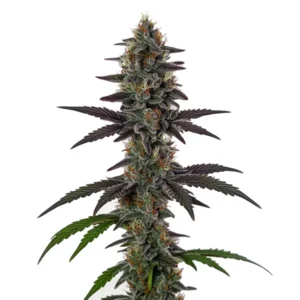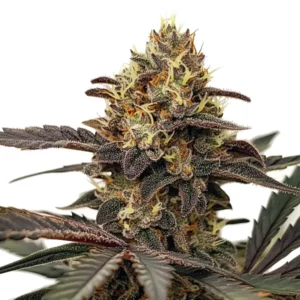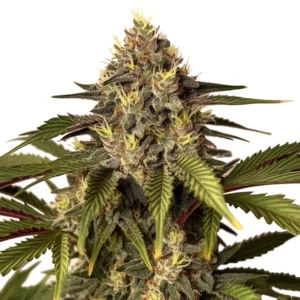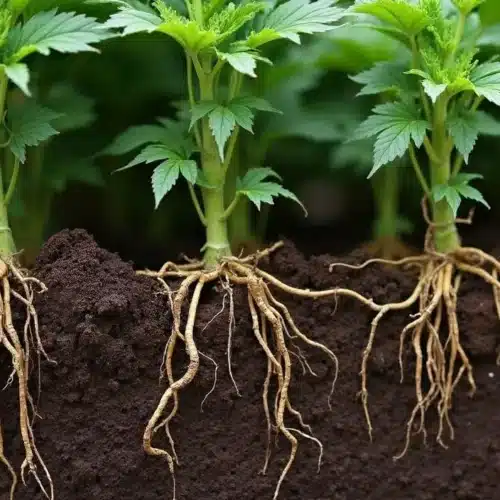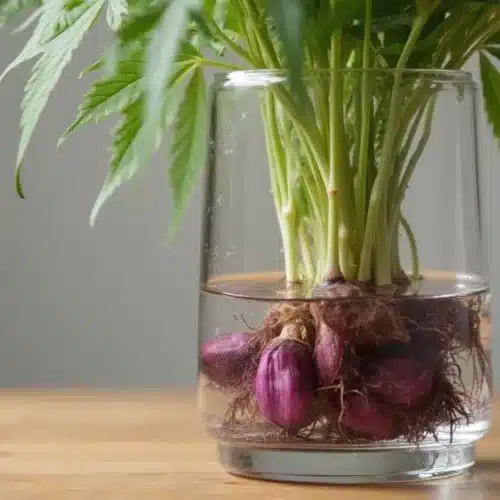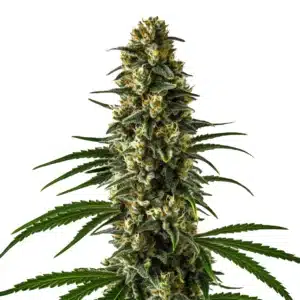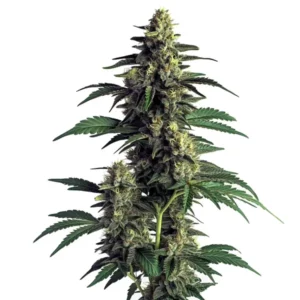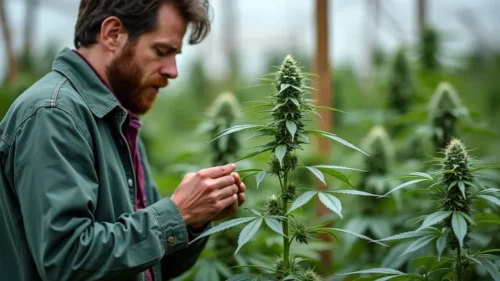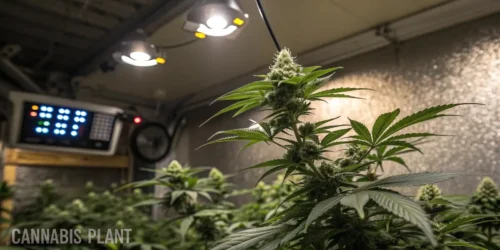Growing cannabis can be a stimulating and fulfilling venture. Whether you’re a newcomer excited about your first grow or a seasoned grower looking to refine your skills, knowing proper plant nutrition is crucial. Using the best nutrients for cannabis growth significantly impacts everything from root development to the quality of flower production.
Essential Macronutrients
Cannabis plants thrive on a variety of macronutrients. The three primary macronutrients are nitrogen (N), phosphorus (P), and potassium (K). These nutrients play a fundamental role in the different growth stages of the plant, making them critical for a successful grow.
Think about these nutrients as the building blocks of plant health, providing essential support as your plants move from sprouting to flowering. Understanding each one will ensure your plants receive what they need at the right time!
Nitrogen (N)
Nitrogen is key for vigorous vegetative growth. This nutrient plays a critical role in the formation of proteins and chlorophyll, both of which are essential for photosynthesis. During the vegetative phase of growth, your cannabis plants will require higher nitrogen levels to promote lush leaf expansion.
However, keep in mind that too much nitrogen during the flowering phase can lead to unwanted excessive foliage instead of robust flower development. Therefore, a balanced approach is fundamental when transitioning between growth stages.
Phosphorus (P)
Phosphorus is important for energy transfer within the plant and is crucial for the overall health of your cannabis. As one of the best nutrients for cannabis growth, phosphorus plays a key role in root development and should be prioritized during the flowering period when plants need it most for producing abundant flowers and healthy buds.
If you notice signs like stunted growth or dark green to purplish leaves, these may indicate a phosphorus deficiency. To combat this, think of incorporating fertilizers that are rich in phosphorus during the flowering phase for optimal results.
Potassium (K)
Potassium plays a significant role in regulating several processes within cannabis plants, including water uptake and enzyme activation. This nutrient helps strengthen the plant’s cell walls, contributing greatly to overall plant health and vigor.
In the late flowering stage, potassium is vital for enhancing both the flavor and size of buds. A well-balanced intake of potassium can go a long way in maximizing both the yield and the quality of your harvest. A little extra care at this stage can make a big difference come harvest time!
Promos & Deals
Micronutrients Matter Too
While the spotlight often shines on macronutrients, don’t overlook the importance of micronutrients like calcium, magnesium, and iron. These elements are necessary in smaller amounts but are crucial for your plants’ overall health. In fact, a balanced combination of both macro and micronutrients is essential when choosing the best cannabis plant food, ensuring strong development and optimal yields.
Just like a well-rounded diet is essential for humans, cannabis plants thrive on a diverse nutrient profile. Including these micronutrients will support healthy growth and resilient plants.
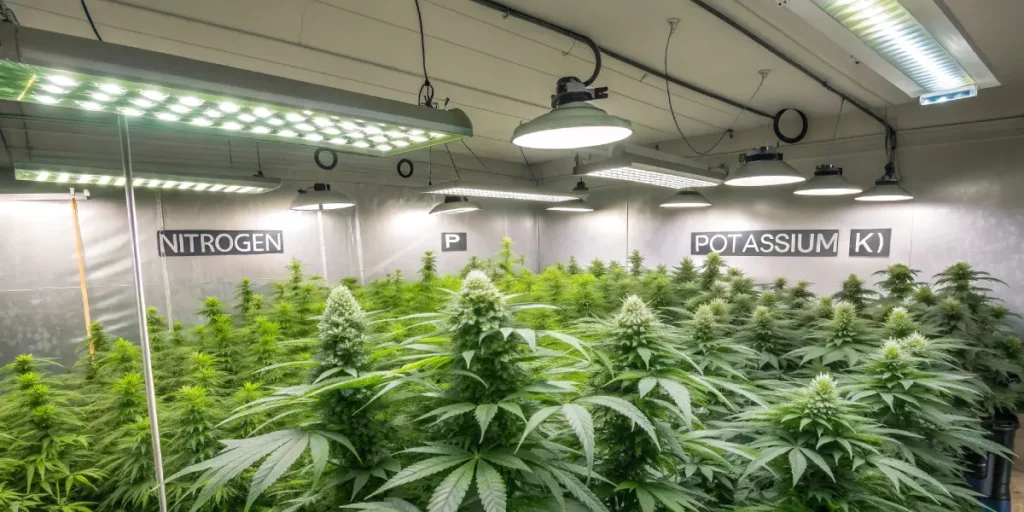
Calcium
Calcium is essential for strong cellular structures, playing a pivotal role in nutrient uptake. Insufficient calcium can lead to problems like blossom end rot, so ensuring an adequate supply is crucial for healthy plants.
A simple way to provide calcium is by adding lime to your soil or using calcium-rich fertilizers. This practice not only fortifies your plants but also enhances the overall soil structure, promoting a more balanced ecosystem.
Magnesium
Magnesium is a major component of chlorophyll, which is key for photosynthesis. If your cannabis plants start showing yellowing leaves, especially those older leaves, it might be a sign of magnesium deficiency.
To tackle this issue, consider supplementing with Epsom salt, it’s effective and easy to incorporate. Just mix some into your watering routine, and you’ll likely notice your plants responding positively in no time.
Iron
Iron, though required in smaller quantities compared to other nutrients, is critical for chlorophyll production. A lack of iron could cause unusual leaf coloration and diminished overall vigor in your plants.
Monitoring nutrient balance is key here, and the incorporation of iron supplements can readily resolve deficiencies. Regular assessments will help you catch any imbalances early before they escalate into more significant issues.
Common Nutrient Sources
When it comes to sourcing nutrients, both organic and synthetic fertilizers can be effective options. Knowing their distinct advantages and characteristics can help you choose the best route for your cultivation approach. Selecting the best nutrients for cannabis growth ensures your plants receive optimal support throughout each stage of development.
Regardless of which type you lean towards, always consider how these nutrients integrate into your broader growing strategy. The right choice will depend on your specific preferences and growing conditions.
Organic Nutrients
Organic fertilizers encompass products like compost, manure, and natural minerals. They not only provide essential nutrients but also improve soil structure and encourage beneficial microorganisms in the soil ecosystem.
Many growers find that organic methods resonate with their desire for sustainable practices. Organic fertilizers release nutrients more gradually, ensuring a steady supply over time that supports continued plant growth.
Synthetic Nutrients
On the other hand, synthetic fertilizers can deliver nutrients more rapidly and precisely, making them an excellent option for those seeking quick, impactful results. Often considered among the best nutrients for cannabis growth when used correctly, they require meticulous application to avoid nutrient burn.
Many commercial nutrient solutions are tailored specifically for cannabis, taking into account its unique growth stages. Whenever using these products, it’s essential to follow the manufacturer’s guidelines carefully to maintain optimal results.
Nutrient pH Balance
Maintaining accurate pH levels is crucial for ensuring nutrient availability to your plants. Cannabis generally thrives at a pH range of 6.0 to 7.0 when grown in soil and between 5.5 to 6.5 in hydroponic systems.
Going outside of these pH levels can hinder nutrient uptake, leading to potential deficiencies even when nutrient levels in the soil appear adequate. Regular pH testing can proactively prevent these complications, keeping your plants healthy and vibrant.
Signs of Nutrient Deficiency
Properly managing a nutrient regimen is vital for healthy plants, but sometimes they may display deficiency symptoms. Recognizing these signs early can be the difference between a thriving plant and one that struggles. Using the best nutrients for cannabis growth helps prevent such issues by ensuring the plant receives a balanced supply of essential elements from the start.
Being observant and proactive can help you catch these issues before they become critical. Let’s look at some common deficiency signs and how to address them effectively.
Yellowing Leaves
Yellowing leaves are often among the first signs of nutrient deficiencies, particularly those related to nitrogen or magnesium. It’s essential to assess the entire plant to determine whether the issue is isolated or more widespread.
To reverse the yellowing, recalibrating your nutrient plan or incorporating specific supplements can be beneficial. Experimenting and finding the right balance for your plants can lead to noticeable improvements.
Stunted Growth
When your plants aren’t growing as expected, it’s time to check nutrient levels and consider other environmental factors. Stunted growth may also arise from issues like poor root health, imbalanced pH, or insufficient lighting.
Investing in quality grow lights and maintaining the right environmental conditions will provide the necessary support for your plants, fostering healthy and dynamic growth.
Feeding Schedule
Establishing a consistent feeding schedule helps ensure your plants receive nutrients at optimal times. Many growers begin with a basic schedule tailored to the plant’s growth phase, refining it as needed over time.
A reliable and well-timed feeding regimen simplifies the process and can lead to gratifying results in your harvest. Knowing when and how to adjust can significantly enhance your success!
Vegetative Stage
During the vegetative stage, higher nitrogen ratios are ideal to support vigorous leaf and stem growth. Many growers opt to feed their plants every one to two weeks with a nitrogen-rich fertilizer during this time.
As your plants increase in size, consider boosting the strength of your nutrient solution to offer the robust support they need for thriving growth. You’re setting yourself up for success by staying engaged with your plants!
Flowering Stage
In the flowering stage, it’s time to shift to fertilizers with higher levels of phosphorus and potassium to promote better bud formation. Choosing the best nutrients for cannabis growth during this phase is essential to maximize yield and resin production. Paying close attention to your plants allows you to make timely adjustments to your feeding regimen.
Typically, feeding frequency may be reduced to every two weeks during this crucial phase, allowing you to perfect the nutrient balance and support your plants’ development effectively.
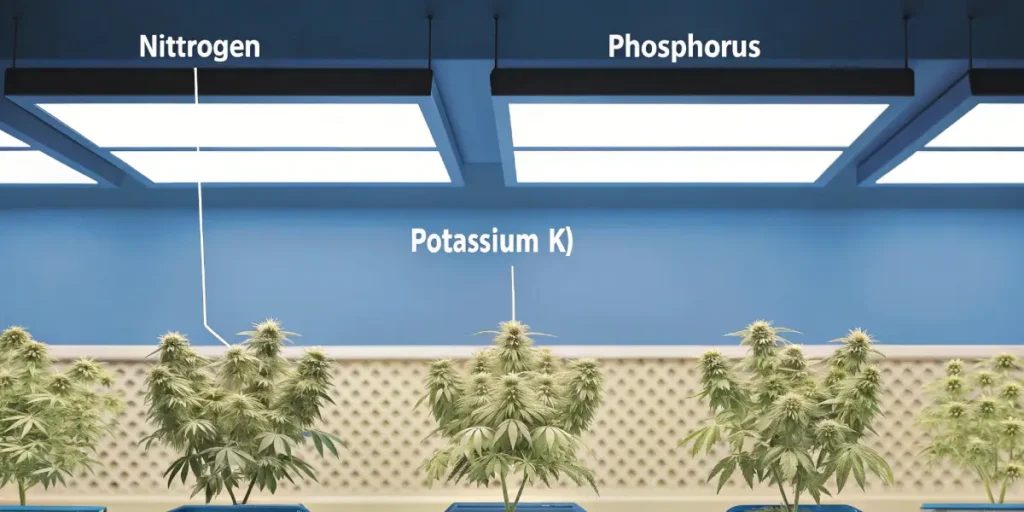
Choosing the Right Strains
The variety of cannabis strain you choose can also significantly impact its nutrient needs. Different strains have unique requirements and growth behaviors, making it essential to align your nutrient strategy with your chosen strain. Choosing the best base nutrients for cannabis ensures that each plant receives the right balance of essential elements, promoting healthy growth and maximizing yield.
Knowing the specifics of each strain can help you tailor your approach and enhance your cultivation experience. Let’s highlight a few popular strains and their nutrient preferences!
Blue Dream
This widely loved strain thrives on a balanced nutrient profile. Its robust nature often leads to a smooth and manageable growing experience, appealing to both novices and seasoned growers alike.
For Blue Dream, sticking with a balanced nutrient regimen throughout its life cycle helps ensure optimal yields and rich flavors in the end product! You’ll appreciate the beautiful buds this strain has to offer.
Girl Scout Cookies
Renowned for its unmistakable flavor and potency, Girl Scout Cookies flourish with a nutrient plan that emphasizes phosphorus during its flowering stage. This attention to detail pays off with stunning, resinous buds.
By focusing on phosphorus during this critical growth stage, you’ll enhance the flower structure and the overall quality of your harvest. The rewards are well worth the effort!
Northern Lights
Northern Lights is often a favorite among indoor growers. This strain responds exceptionally well to a straightforward nutrient regimen, making it approachable for beginners and an excellent choice for anyone looking to maximize their grow’s potential.
Its forgiving nature means that once you establish a solid feeding routine, you’re likely to enjoy a bountiful harvest without too much complexity. It’s a great confidence builder for new growers!
FAQs
What is nutrient burn?
Nutrient burn occurs when plants receive an excessive amount of nutrients, often resulting in browning and crisping of leaf tips. To resolve this issue, it’s best to adjust the nutrient concentrations and consider flushing the soil with purified water to remove excess nutrients. Using only the best cannabis nutrients can help prevent overfeeding while ensuring optimal plant health and balanced growth.
Being proactive and ensuring that your feeding plan remains balanced will help prevent nutrient burn from becoming a problem in the first place. Healthy plants are happy plants!
How often should I test my soil for nutrients?
Regularly testing your soil’s nutrient levels and pH, ideally once a month during the growing season, is good practice. This proactive approach allows you to spot any discrepancies early and make necessary adjustments before issues develop.
Routine soil testing is like regular health check-ups for your plants, keeping them thriving and vibrant requires consistent attention!
Can I use tap water for my cannabis plants?
Using tap water can be feasible; however, it’s wise to let it sit for 24 hours before use to allow excessive chlorine to dissipate. For enhanced outcomes, consider filtering your water or using distilled options for the best possible results in your garden.
Water is a critical component of your plants’ health, so treating it with care sets the stage for successful growth!
What are some signs of overwatering?
Overwatering can manifest as wilting, drooping leaves, and root rot. To promote healthy growth, allow the soil to dry out between waterings, maintaining a balance that encourages healthy root development.
A straightforward rule of thumb is to check the top inch of soil; if it feels dry, it’s likely time for a drink! This approach helps ensure your plants receive the moisture they need without the risk of drowning.

